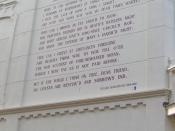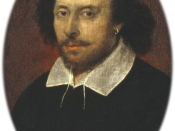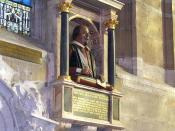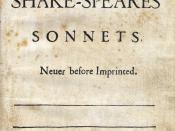The Countdown of Mortality In many of his sonnets, William Shakespeare explores the issues of death, time, and beauty in human life. But perhaps none of the sonnets present as bleak an outlook on the as sonnet 12. The sonnet essentially confronts the reader with his/her own mortality. What is it about the sonnet that allows it to have such effect? The actual content of the poem is indeed effective, but the true power comes from the combination of content and form. Shakespeare flawlessly and effectively uses the mechanics of the poem to enhance its content, allowing it to have the devastating effect on the reader that it does.
The content of sonnet 12 describes the aging of living things as time passes. The overall tone is solemn and the mood is set by the first line, "When I do count the clock that tells the time"ÃÂ (1). The first idea we come across is waiting.
Watching a clock slows the passage of time, giving time a predatory attribute, as if it is slowly creeping up on us for the strike. It is important to note that the speaker repeatedly uses "I"ÃÂ. Thus, the poem is subjective and the speaker is projecting upon his own death. Then in lines 2-8, the speaker's provides his observations over the course of time. He describes the "violet past prime"ÃÂ (3), the death of a kind of flower, and "sable curls all silvered"ÃÂ (4), the graying of one's hair. The idea Shakespeare brings up here is that time consumes everything. The word choices in these lines are indicative of this: "Sunk"ÃÂ, "hideous"ÃÂ, "barren"ÃÂ, "girded"ÃÂ, all these words present the idea of decay and rotting.
In line 9, Shakespeare changes the subject matter: "Then of thy beauty do I question make / that thou among the wastes of time must go"æ"ÃÂ(9-10). Shakespeare is questioning the permanence of things beautiful. "Sweets and beauties"à(11) are not immune to time's destructive forces. They too will decay just like everything else. Thus, Shakespeare destroys the importance of physical beauty because it is no exception to time's power. In the final rhyming couplet, Shakespeare concludes his grim projection of the future with a personification of time: "And nothing gainst time's scythe can make defence"æ"à(13). A scythe is a tool with a long, curved blade characteristically held by Death. Thus, Shakespeare finds death and time to be one in the same. Time is destruction and decay, it is a predator, and it is a consumer. The many presentations of time in the poem succeed in reinforcing the utter hopelessness in the battle against time. Shakespeare does, however, offer a small glimpse of hope in the final line: "Save breed to brave him when he takes thee hence."à(14). By having children, one can pass on his/her beauty and delay time's victory. For Shakespeare, his "breed"àmay perhaps be his works. The beauty of his writings can stand up to the test of time. The knowledge that one will leave something lasting provides bravery in the face of death.
Now that we understand the poems textual meaning, we can see how effectively Shakespeare uses form to enhance that meaning. Proper meter for Elizabethan sonnets is Iambic Pentameter. This means that each line generally has five feet of Iambs, which are unstressed/stressed. Sonnet 12 however, contains an abundance of spondees, feet that are stressed/stressed. This can be seen in line two with "brave day"ÃÂ and in line three with "past prime"ÃÂ. This establishes a ticking rhythm, like the tick-tock of a clock. The alliteration of the "c"ÃÂ and "t"ÃÂ sounds also creates this tick-tock effect: "When I do count the clock that tells the time"ÃÂ (1). The meter and alliteration of the poem follows the image of the clock brought up in line and the idea of passing time.
The punctuation of the poem also mirrors its meaning. Almost all of the lines are punctuated at the ends of the lines themselves: When I behold the violet past prime, And sable curls all silvered o're with white, When lofty trees I see barren of leaves, Which erst from heat did canopy the herd,"æ(3-6) Notice how each line ends with a comma. This serves to create two effects: First, it is as if each line is born as the beginning of the line and dies at the end with the punctuation. Combined with the tick-tock of the meter, this reinforces that the passage of time destroys everything. As time passes, marked by the meter, the line ceases to exist. Then a new line is created, thus mirroring the birth and death of nature. The second thing the ending lines establish, in looking at the poem as a whole, is a countdown, with each line composing a beat. The poem counts down to its end, projecting its own mortality just like the speaker does.
Unlike the rest of the poem, the lines in the final rhyming couplet are not separated by punctuation: "And nothing "ÃÂgainst time's scythe can make defence / save breed to brave him when he takes the hence."ÃÂ (13-14). In these lines, Shakespeare suggests the only weapon against time is breeding. Again, the form mirrors the meaning. Once Shakespeare brings up the weapon of reproduction against time, the countdown effect of the poem is disrupted and slowed. The idea lives longer than those in the other lines of the poem.
In sonnet 12, Shakespeare seamlessly combines meaning and form to create a poem with such power that mortality stares the reader in the face. Both the text and the mechanical devices in the poem are used to effectively express the ravaging effects of time on all things beautiful. The meter, alliteration, and layout of the poem all serve to reinforce this idea by establishing a countdown effect that projects the death of the speaker, the reader, and the poem itself. Even the placement of the poem as the twelfth sonnet (12 hours in a cycle), is used to carry meaning. In sonnet 12, it is obvious that Shakespeare truly takes advantage of even the smallest nuances of sonnet form.





